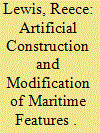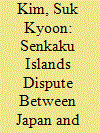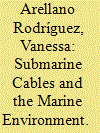| Srl | Item |
| 1 |
ID:
181404


|
|
|
|
|
| Summary/Abstract |
Coastal states create and modify maritime features. The law of the sea recognizes the existence of artificial islands, installations, and structures. It also defines islands and low-tide elevations as “naturally formed” areas of land. Thus far, however, these concepts have been ambiguously interpreted and applied. This article puts forward a clearer approach. It reemphasizes some of the fundamental principles of international law by demonstrating that a feature’s capability of sovereign appropriation should determine its legal treatment.
|
|
|
|
|
|
|
|
|
|
|
|
|
|
|
|
| 2 |
ID:
181403


|
|
|
|
|
| Summary/Abstract |
The COVID-19 pandemic has exposed additional weaknesses of the already troubling “flag of convenience” practices under international law; the passenger cruise industry was especially impacted. Most cruise ships under distress from the pandemic received little aid from their flag states, and many vessels were denied entry into ports of nonflag states (regardless of whether an outbreak had been documented onboard). States and vessels lacked clear guidance around their rights and responsibilities under the extraordinary circumstances, resulting in a less efficient response to a dangerous situation. This article reviews the current status of international law concerning port and flag state duties to distressed vessels, and suggests the creation of flag state medical liability to help clarify decision-making during future health crises.
|
|
|
|
|
|
|
|
|
|
|
|
|
|
|
|
| 3 |
ID:
181407


|
|
|
|
|
| Summary/Abstract |
This article explores the plausibility of submitting disputes concerning activities in undelimited maritime areas to United Nations Convention on the Law of Sea (UNCLOS) compulsory procedures in order to invoke the state responsibility of the coastal state for breaching its obligations pending maritime delimitation. Key to this question is the establishment of an UNCLOS tribunal’s jurisdiction over the dispute. By examining the claims on the basis of Articles 74(3) and 83(3) of UNCLOS, and of other UNCLOS provisions that are not in themselves excluded from UNCLOS compulsory dispute resolution procedures, this article discusses the respective strengths and weakness of the two avenues toward the UNCLOS dispute settlement mechanism.
|
|
|
|
|
|
|
|
|
|
|
|
|
|
|
|
| 4 |
ID:
181405


|
|
|
|
|
| Summary/Abstract |
In recent years, the dispute over the Senkaku (Diaoyu) Islands, which had been modestly managed with no significant challenge to Japan’s effective control, has developed into a new phase, with heightened tensions and a risk of clashes. A notable trend is that the intrusions of China Coast Guard ships into the Japanese contiguous zone and territorial sea off the Senkaku islands have become more frequent and their stay in these waters has become longer. China appears to have shifted its strategy from a regular presence in these waters to the exercise of law enforcement authority in sovereign waters.
|
|
|
|
|
|
|
|
|
|
|
|
|
|
|
|
| 5 |
ID:
181406


|
|
|
|
|
| Summary/Abstract |
Renowned for its unique flora and fauna, the Galapagos Archipelago is also home to a growing population of more than 25,000 people. Despite receiving approximately 200,000 tourists each year, and having governmental and nongovernmental offices, two airports, and various other human developments, the Archipelago’s telecommunications remain largely dependent on satellites. The absence of submarine telecommunication cables has not gone unnoticed, and the Archipelago is currently in the spotlight for two potential submarine cable projects. Although the environmental impact of submarine cables is generally deemed to be minimal, the pressure that new anthropogenic activities may add to the Galapagos cannot be disregarded. Two important aspects warrant specific attention in this regard: The Galapagos Archipelago’s surrounding waters have been designated as a marine protected area (MPA) and also a particularly sensitive sea area (PSSA) by the International Maritime Organization (IMO). Hence, using the Galapagos as a case study could serve as yardstick from which to assess the central question of this article: To what extent can coastal states regulate submarine cable operations for the protection and preservation of the marine environment?
|
|
|
|
|
|
|
|
|
|
|
|
|
|
|
|